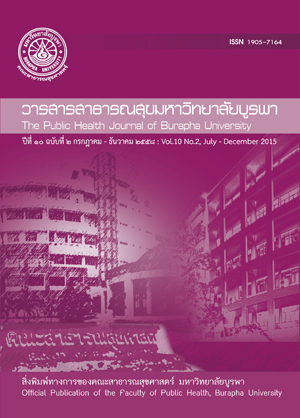ความจำเป็นของการดูแลแบบประคับประคองในชุมชนของผู้ป่วยโรคเรื้อรังระยะท้าย: กรณีศึกษาเครือข่ายบริการปฐมภูมิแห่งหนึ่ง
Main Article Content
บทคัดย่อ
การศึกษาเชิงคุณภาพนี้มีวัตถุประสงค์เพื่อประเมินประสบการณ์การให้บริการดูแลผู้ป่วยแบบประคับประคองของทีมสุขภาพที่ปฏิบัติงานในเครือข่ายบริการปฐมภูมิและประเมินความจำเป็นทางสุขภาพของผู้ป่วยเรื้อรังระยะสุดท้าย รวบรวมข้อมูลโดยวิธี snowball sampling ทีมสุขภาพ จำนวน 10 คน และผู้ดูแลผู้ป่วยจำนวน 10 คน ทำการสัมภาษณ์เชิงลึกและสนทนากลุ่มโดยใช้แนวทางคำสัมภาษณ์และวิเคราะห์ข้อมูลด้วยการวิเคราะห์แก่นสาระ ผลการศึกษาพบว่า ทีมสุขภาพปฏิบัติงานในบทบาทการดูแลผู้ป่วยแบบประคับประคองครบถ้วนตามหลักการเน้นผู้ป่วยและครอบครัวเป็นศูนย์กลาง การดูแลแบบองค์รวม เชื่อมประสาน และต่อเนื่อง แต่ยังไม่ได้กำหนดมาตรฐานการปฏิบัติงานและวางแผนดูแลผู้ป่วยจากโรงพยาบาลสู่ชุมชนร่วมกันในทีมสุขภาพชุมชน การปฏิบัติของพยาบาลทำให้เข้าถึงผู้ป่วยได้ดีและอาสาสมัครสาธารณสุขประจำหมู่บ้านสนับสนุนการดูแลที่บ้านแก่ทีมสุขภาพได้ ด้านความจำเป็นทางสุขภาพของผู้ป่วยพบว่า ผู้ดูแลต้องการความมั่นใจในการดูแลภาวะวิกฤติที่บ้าน การสนับสนุนการดูแลทางกายและจิตสังคมทั้งก่อนและภายหลังการสูญเสียจากอาสาสมัครสาธารณสุขประจำหมู่บ้าน การสื่อสารเรื่องการพยากรณ์โรคเพื่อวางแผนการดูแลของครอบครัวจากบุคลากรสุขภาพและการสนับสนุนของทีมผู้นำชุมชนในการเข้าถึงบริการสุขภาพกรณีมีข้อจำกัดของครอบครัว โดยสรุปพยาบาลเยี่ยมบ้านมีบทบาทสำคัญต่อการดำเนินงานทั้งในระดับโรงพยาบาลและชุมชน การดูแลแบบประคับประคองควรเริ่มตั้งแต่การวินิจฉัยโรค และมีการวางแผนการดูแลรายป่วยในชุมชนร่วมกันระหว่างโรงพยาบาลและหน่วยบริการสุขภาพในชุมชน ก่อนจำหน่ายออกจากโรงพยาบาล อาสาสมัครสาธารณสุขประจำหมู่บ้านควรได้รับการเพิ่มสมรรถนะการดูแลที่บ้านอย่างต่อเนื่อง หน่วยบริการปฐมภูมิควรได้รับการส่งเสริมให้จัดบริการดูแลผู้ป่วยเรื้อรังแบบประคับประคองในชุมชน
The Need of Palliative Care for the End-of-Life Chronic Patients in a Community: A Case Study of a Primary Care Unit/Network
This qualitative study aimed to evaluate the experience of a primary healthcare team for palliative care services and the health needs of end-of-life chronic patients. The technique of snowball sampling was implemented for data collection, which yielded 10 health personnel and 10 caregivers. Thematic analysis was used for in-depth interviews and focus-group discussions. The results revealed that the health team operated the palliative care practice based on the principle of patient-centered and family-centered health care, and on the principle of comprehensive, coordinated and continuous healthcare; however, there was no standard practice and patient-care planning from the hospital to the community health team. The study showed that the nurses were the ones who had access to the patients in the hospital, and the village health volunteers provided health care in the community. In terms of the patients’ needs, the caregiver wanted to have confidence to provide intensive care to the patients at home. The village health volunteer wanted to provide physical and psychosocial support before and after bereavement. Health personnel wanted to provide the communication of the disease prognosis for the planning of family care. And the community leaders wanted to provide the support for access to health care for those who had access-limitations. In conclusion, the study showed that the home-visit nurse played an important role in the palliative care both in the hospital and in the community. Also, in conclusion, the study recommends that the palliative care should start from the time of disease diagnosis, and the planning of patient care in the community between the community hospital and the community care unit should start before discharge. The community health volunteers should be encouraged to improve their capacity to provide continuous healthcare at the patients’ homes, and the primary care unit should be encouraged to conduct palliative care services for chronic patients in the community.
Article Details
เอกสารอ้างอิง
2. สำนักระบาดวิทยา กระทรวงสาธารณสุข. รายงานการเฝ้าระวังโรคไม่ติดต่อเรื้อรัง พ.ศ. 2555 (ออนไลน์). เข้าถึงได้จาก: http://www.boe.moph.go.th/files/report/20140109_40197220.pdf. (วันที่ค้นข้อมูล 10 เมษายน 2557).
3. สุพัตรา ศรีวณิชชากร. Palliative Care: การดูแลและเยียวยาด้วยหัวใจและศรัทธา. (ออนไลน์). เข้าถึงได้จาก: http://www.thaiichr.org/upload/forum/PCFM05.pdf. (วันที่ค้นข้อมูล 12 เมษายน 2557).
4. WHO. WHO definition of palliative care. [online]. 2005 [cited 2014 January 31]. Available from: http://www.who.int/cancer/palliative/definition/en/.
5. ฝ่ายการพยาบาล โรงพยาบาลมหาราชนครเชียงใหม่. Palliative Performance Scale version 2 ฉบับสวนดอก. (ออนไลน์). เข้าถึงได้จาก: www.med.cmu.ac.th/hospital/nis/palliative.html. (วันที่ค้นข้อมูล 20 มกราคม 2557).
6. โรงพยาบาลมหาราชนครเชียงใหม่และโรงพยาบาลเครือข่าย. แผนการดูแลผู้ป่วยแบบประคับประคองและครอบครัวอย่างต่อเนื่อง. (ออนไลน์). เข้าถึงได้จาก: www.med.cmu.ac.th/.../2012-09-04-02-46-57?. (วันที่ค้นข้อมูล 15 เมษายน 2557).
7. Steinhauser KE, Measuring end-of-life care outcomes perspectively. J Palliat Med 2005; 8 (1): s30-41.
8. จินตนา อาจสันเที๊ยะ. การพยาบาลแบบประคับประคองในชุมชนตามวิถีแบบพุทธ. (ออนไลน์). เข้าถึงได้จาก: www.tci-thaijo.org/index.php/JRTAN/article/.../10863. (วันที่ค้นข้อมูล 15 เมษายน 2557).
9. พนมพร เฉลิมชาติ. Palliative care in Yasothon. (ออนไลน์). เข้าถึงได้จาก: hospitalhttp://www.yasohospital.org/information/Palliativecare.pdf (วันที่ค้นข้อมูล 15 เมษายน 2557).
10. วรรณภรณ์ พัฒนิบูลย์, จีรพันธ์ ประทุมอ่อน, จุธาลักษณ์ แก้วมะไฟ. การพัฒนารูปแบบการดูแลแบบประคับประคองสำหรับผู้ป่วยสูงอายุที่เจ็บป่วยเรื้อรังในระยะสุดท้าย หอผู้ป่วยอายุรกรรม 2 โรงพยาบาลร้อยเอ็ด. (ออนไลน์). เข้าถึงได้จาก: www.tci-thaijo.org/index.php/jnat-ned/article/.../2940. (วันที่ค้นข้อมูล 17 เมษายน 2557).
11. โรงพยาบาลสงฆ์ กระทรวงสาธารณสุข. แนวทางเวชปฏิบัติการดูแลรักษาแบบประคับประคอง. (ออนไลน์). เข้าถึงได้จาก: www.priest-hospital.go.th/health_handbook/Palliative_care.pdf. (วันที่ค้นข้อมูล 17 เมษายน 2557).
12. Laura C. Hanson, Barbara Usher, Lynn Spragens, and Stephen Bernard. [online]. 2008 [cited 2014 March 14]. Available from: http://www.sciencedirect.com/science/article/pii/S0885392407007397.
13. Thomas J. Smith and J. Brian Cassel. Cost and Non-Clinical Outcomes of Palliative Care. [online]. 2009 [cited 2014 March 14]. Available from: http://www.sciencedirect.com/science/article/pii/S0885392409005284. (Accessed on 13 March 2014).

